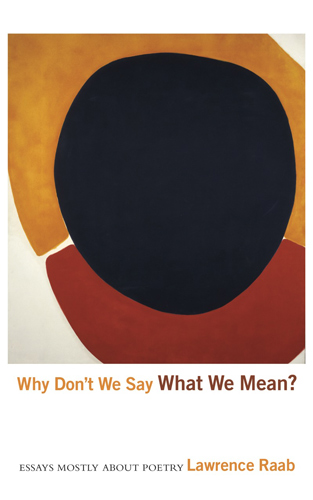Why Don’t We Say What We Mean?
Lawrence Raab poses the question Why Don’t We Say What We Mean? as the title of his newest book. To answer the question, he dissects various poems and comments on their authors. The title was pulled from a 1931 essay by Robert Frost called “Education by Poetry: A Meditative Monologue.” Frost wrote: “People say, ‘Why don’t you say what you mean?’ We never do that, do we, being all of us too much poets.”
Lawrence Raab poses the question Why Don’t We Say What We Mean? as the title of his newest book. To answer the question, he dissects various poems and comments on their authors. The title was pulled from a 1931 essay by Robert Frost called “Education by Poetry: A Meditative Monologue.” Frost wrote: “People say, ‘Why don’t you say what you mean?’ We never do that, do we, being all of us too much poets.”
Raab’s essays focus on Frost and other old-boys-club poets like Paul Valéry, Richard Wilbur, W.H. Auden, and Ben Jonson, along with women of standing including Elizabeth Bishop, Gertrude Stein, and the ubiquitous Emily Dickinson.
The chapters in Why Don’t We Say What We Mean? have catchy headings, my favorite being “Poetry and Stupidity.” Don’t interpret this as a putdown. In the English translation of a work by Valéry, the French word bétise was translated as stupidity, but Raab prefers to define it as foolishness, and places poetic blunders and errors under the same umbrella. He explains:
If the poet begins by playing with language, unaware of where the words might lead him, blunders and errors are inevitable. [ . . . ] The poet must value not understanding, that kind of stupidity. The poet must also know when to become smart. This begins with the discovery of the true subject of the poem, the surprise of recognizing what could not have been predicted.
In the chapter, “Choosing the Wrong Subject,” Raab writes that poets often think they know the subject of their poem when they begin writing it. Then the subject “expands, or contracts, or changes. If the original subject seemingly disappears, it may not have been displaced so much as deepened. And if it has truly vanished, the poet can return to it later. Another potential poem has presented itself.”
Elsewhere, he covers James Wright’s poem “Lying in a Hammock at William Duffy’s Farm in Pine Island, Minnesota.” It starts out serenely showing us what the person in the hammock notices: a bronze butterfly, a field of sunlight, etc. Then ends with:
I lean back, as the evening darkens and comes on.
A chicken hawk floats over, looking for home.
I have wasted my life.
Raab tells us the startling last line can be interpreted negatively: “One response would emphasize sorrow—the speaker has indeed wasted his life, perhaps by failing to notice [ . . . ] the world around him.” Or positively: “Thank God I have wasted my life, have spent my time paying attention to the world.” Showing both options allows readers to make their own conclusions about the piece. He then goes into much greater detail analyzing this and each of the other poems he highlights.
Frost appears later in the book with his poem “Mending Wall,” which opens with a riddle: “Something there is that doesn’t love a wall.” Raab shows how a riddle works in a poem, writing, “And a riddle, after all, is a series of hints calculated to make us imagine and then name its hidden subject. [ . . . ] Its first gesture is one of elaborate and playful concealment, a calculated withholding of meaning.” This particular poem ends with the line that has worked its way into our vernacular: “Good fences make good neighbors.”
In the book’s final chapter, Raab tackles writing poetry based on dreams. He cautions:
Although dreams themselves may seem curiously coherent to the dreamer, a dream poem that merely offers itself the freedom to move anywhere without any coherent structure to contain it is doomed to annoying insignificance.
One of his own dreams was “haunting and disturbing and interesting,” so he tried importing it into a poem “where it just sat there, all of its mysterious impact gone.” Though that particular poem lies dormant, he affirms that “part of the allure of dreams—and of poems—resides in the possibility of interpretation, the uncovering of hidden significance.”
Raab’s in-depth analyses of poetry and poets in Why Don’t We Say What We Mean?: Essays Mostly About Poetry will be available December first. This is not a book to rush through, as some of it is stylistically academic. But it’s infused with insightful quotes and is obviously a labor of love. If you like learning about and studying poetry—stepping beyond simply reading it—this book will be well worth your time.





